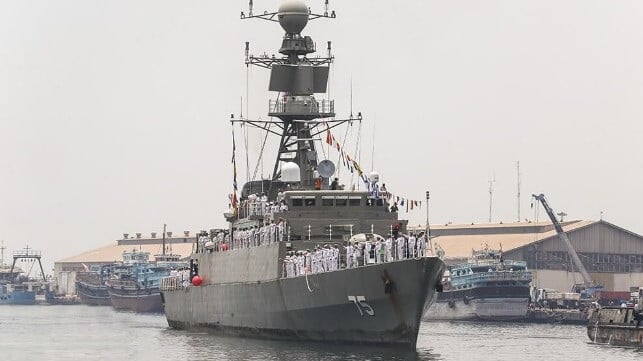Iran Withdraws From the Red Sea

With two US Carrier Strike Groups (CSGs) now operating in the area, it appears that the regular Iranian Navy (Nedaja) has withdrawn from the Red Sea and Gulf of Aden station.
The Nedaja has maintained a continuous presence in the Red Sea and Gulf of Aden area since 2008. Typically, deployments have consisted of a Moudge or Bayandor Class frigate, supported by a Bandar Abbas logistics vessel, or a Hengham Class landing ship operating in a logistics role. Deployments have usually been of 90 days duration, sometimes either shorter or longer, and have often involved a port call in Salalah on the way home. Returns to port have usually been greeted by a senior Nedaja commander and a press announcement, with details given of the flotilla that has deployed to replace the incoming vessels.
Since the 99th Flotilla, comprised of IRINS Dena (F75) and IRINS Bushehr (K422), completed its deployment at the end of last year, the 100th Flotilla may have visited the Gulf of Aden. But the primary mission of the 100th Flotilla was to take 200 cadets from the Imam Khomeini Naval University on their annual winter training cruise, and in this role the flotilla made a port call to Mumbai in late February.
There has been now been no word of Nedaja ships in the Red Sea or Gulf of Aden for several months, so it appears that after over 80 flotillas having successively deployed to the area, the Nedaja has at least temporarily withdrawn its presence. What should have been the Nedaja’s 101st Flotilla has not been seen in the area. If the Nedaja has cunningly succeeded in evading surveillance, it would only have been able to do so by withdrawing from the shipping lanes which hitherto had been its responsibility to patrol, or by redesigning its presence strategy.
The hypothesis that the Nedaja has pulled back is supported by the higher than normal numbers of frigates and support vessels seen in recent months alongside in the Naval Dockyard in Bandar Abbas. For example, on March 18, five frigates plus the intelligence collector IRINS Zagros (H313) were alongside. On March 28, imagery identified four Alvand/Moudge and one Bayandor frigates, together with all three operational Hengham Class landing ships alongside, together implying that there were no long-range flotillas out of home waters at that point.
Recent satellite imagery has also shown that two of the Nedaja’s three Kilo Class submarines are in dry dock in the Bandar Abbas harbour; the one remaining operational Kilo is not, as of this morning and on the basis of poor quality imagery, at its normal berth. The Kilo could be expected to be attempting to shadow the Carl Vinson CSG in the Gulf of Oman, and IRINS Zagros (H313) with other vessels are likely also to be attempting a similar mission.
If confirmed, the withdrawal of the Nedaja from the Red Sea and Gulf of Aden waters would be of significance. The Houthis are known to have relied on the Nedaja and ships of the IRGC Navy to provide intelligence to support their anti-shipping campaign. The Nedaja appears to have withdrawn when the Houthi need for support, under airstrikes mounted from the two US CSGs, is at its most acute.
Top image: Moudge-class frigate IRIS Dena (file image courtesy Fars Media / CC BY 4.0)
